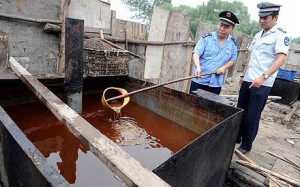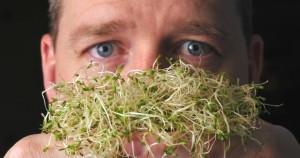Woe is the California lettuce and spinach grower.
"It was just more regulations. More inspections. More paperwork. More filings. More fees," said Chris Bunn, part of a four-generation Salinas Valley farming family. Now in his 60s, he quit two years after the 2006 outbreak. "I miss it terribly," Bunn said. "It was a wonderful business."
Deborah Schoch, a senior writer at the California HealthCare Foundation Center for Health Reporting, writes in the Mercury News today that five years after their healthy-looking green fields became the epicenter of a national food disaster, farmers in the Salinas Valley are still working to regain something even the most bountiful harvest can’t ensure: the public’s trust.
They are doing their best to rebound after investigators linked spinach grown and bagged here to a deadly E. coli strain that would kill three people, sicken 206 more and shake the nation’s faith .jpg) in California leafy greens. So far, they have succeeded in avoiding another major outbreak.
in California leafy greens. So far, they have succeeded in avoiding another major outbreak.
Last year, Monterey County produced spinach worth $127.5 million, down from $188.2 million in 2005, according to reports from the county agricultural commissioner’s office.
Salinas Valley growers and processors have retooled nearly every step in their industry — from planting seedlings to harvesting and washing greens. They have rallied to create a state-industry pact on how to protect 14 types of leafy greens that is being held up as a national model.
"It was the watershed moment for the produce industry," said Joe Pezzini, chief operating officer of Ocean Mist Farms in Castroville.
Too bad it didn’t happen 10 years earlier.
In October, 1996, a 16-month-old Denver girl drank Smoothie juice manufactured by Odwalla Inc. of Half Moon Bay, California. She died several weeks later; 64 others became ill in several western U.S. states and British Columbia after drinking the same juices, which contained unpasteurized apple cider — and E. coli O157:H7. Investigators believed that some of the apples used to make the cider might have been insufficiently washed after falling to the ground and coming into contact with deer feces.
Almost 10 years later, on Sept. 14, 2006, the U.S. Food and Drug Administration announced that an outbreak of E. coli O157: H7 had killed a 77-year-old woman and sickened 49 others (United States Food and Drug Administration, 2006). The FDA learned from the Centers for Disease .jpg) Control and Wisconsin health officials that the outbreak may have been linked to the consumption of produce and identified bagged fresh spinach as a possible cause.
Control and Wisconsin health officials that the outbreak may have been linked to the consumption of produce and identified bagged fresh spinach as a possible cause.
In the decade between these two watershed outbreaks, almost 500 outbreaks of foodborne illness involving fresh produce were documented, publicized and led to some changes within the industry, yet what author Malcolm Gladwell would call a tipping point — "a point at which a slow gradual change becomes irreversible and then proceeds with gathering pace"(http://en.wikipedia.org/wiki/Tipping_Point) — in public awareness about produce-associated risks did not happen until the spinach E. coli O157:H7 outbreak in the fall of 2006. At what point did sufficient evidence exist to compel the fresh produce industry to embrace the kind of change the sector has heralded since 2007? And at what point will future evidence be deemed sufficient to initiate change within an industry?
In 1996, following extensive public and political discussions about microbial food safety in meat, the focus shifted to fresh fruits and vegetables, following an outbreak of Cyclospora cayetanesis ultimately linked to Guatemalan raspberries that sickened 1,465 in 21 U.S. states and two Canadian provinces (U.S. Centers for Disease Control and Prevention, 1997), and subsequently Odwalla. That same year, Beuchat (1996) published a review on pathogenic microorganisms in fresh fruits and vegetables and identified numerous pathways of contamination.
By 1997, researchers at CDC were stating that pathogens could contaminate at any point along the fresh produce food chain — at the farm, processing plant, transportation vehicle, retail store or foodservice operation and the home — and that by understanding where potential problems existed, it was possible to develop strategies to reduce risks of contamination. Researchers also reported that the use of pathogen-free water for washing would minimize risk of contamination.
Yet it would take a decade and some 29 leafy green-related outbreaks before spinach in 2006 became a tipping point.
What was absent in this decade of outbreaks, letters from regulators, plans from industry associations and media accounts, was verification that farmers and others in the farm-to-fork food safety system were seriously internalizing the messages about risk, the numbers of sick people, and translating such information into front-line food safety behavioral change.
Today, according to Schoch, major food and retail chains, from McDonald’s to Walmart, want proof that their lettuce is as clean as any natural product can be.
That means no cattle grazing uphill from a spinach farm, no roaming wild pigs, no farm crews .jpg) without hairnets or gloves, no missing reports.
without hairnets or gloves, no missing reports.
Some food chains even send inspectors unannounced.
"They’ll be the Toyota Camry with the Hertz sticker on the edge of the field, looking with binoculars," said Mike Dobler, 50, a third-generation grower who works with his family on a large-scale vegetable farm based in Watsonville.
"They’re looking to see if you’re doing what you say you’re doing," Dobler said.
Before September 2006, he said, "we were taken at our word, and nobody asked."
Actually, lots of people asked, including FDA, state public health types, journalists, lawyers and academics. Growers apparently just didn’t pay attention.
A table of leafy green related outbreaks is available at http://bites.ksu.edu/leafy-greens-related-outbreaks (they didn’t all originate with California produce, but lots did).
 Following food safety checks by the Department of Primary Industries and Regions
Following food safety checks by the Department of Primary Industries and Regions







.jpg) can be done to ensure the seeds are safe. I wouldn’t be surprised if the next outbreak is even bigger.”
can be done to ensure the seeds are safe. I wouldn’t be surprised if the next outbreak is even bigger.”.jpg) departments and the U.S. Food and Drug Administration. But it had no problem fingering Jensen Farms? Maybe because the Food and Drug Administration named Jensen Farms on Sept. 14 it was open season after that. Maybe CDC was trying to protect other cantaloupe growers. Maybe they’d like to protect other Romaine lettuce growers? Is there a written policy on when to finger a farm? Consistency in communications helps build trust.)
departments and the U.S. Food and Drug Administration. But it had no problem fingering Jensen Farms? Maybe because the Food and Drug Administration named Jensen Farms on Sept. 14 it was open season after that. Maybe CDC was trying to protect other cantaloupe growers. Maybe they’d like to protect other Romaine lettuce growers? Is there a written policy on when to finger a farm? Consistency in communications helps build trust.).jpg) in California leafy greens. So far, they have succeeded in avoiding another major outbreak.
in California leafy greens. So far, they have succeeded in avoiding another major outbreak..jpg) Control and Wisconsin health officials that the outbreak may have been linked to the consumption of produce and identified bagged fresh spinach as a possible cause.
Control and Wisconsin health officials that the outbreak may have been linked to the consumption of produce and identified bagged fresh spinach as a possible cause..jpg) without hairnets or gloves, no missing reports.
without hairnets or gloves, no missing reports..jpg) and when a company is not following the rules, there will be consequences,” howls of cynical guffawing ensued among those familiar with the Canadian Food Inspection Agency.
and when a company is not following the rules, there will be consequences,” howls of cynical guffawing ensued among those familiar with the Canadian Food Inspection Agency.